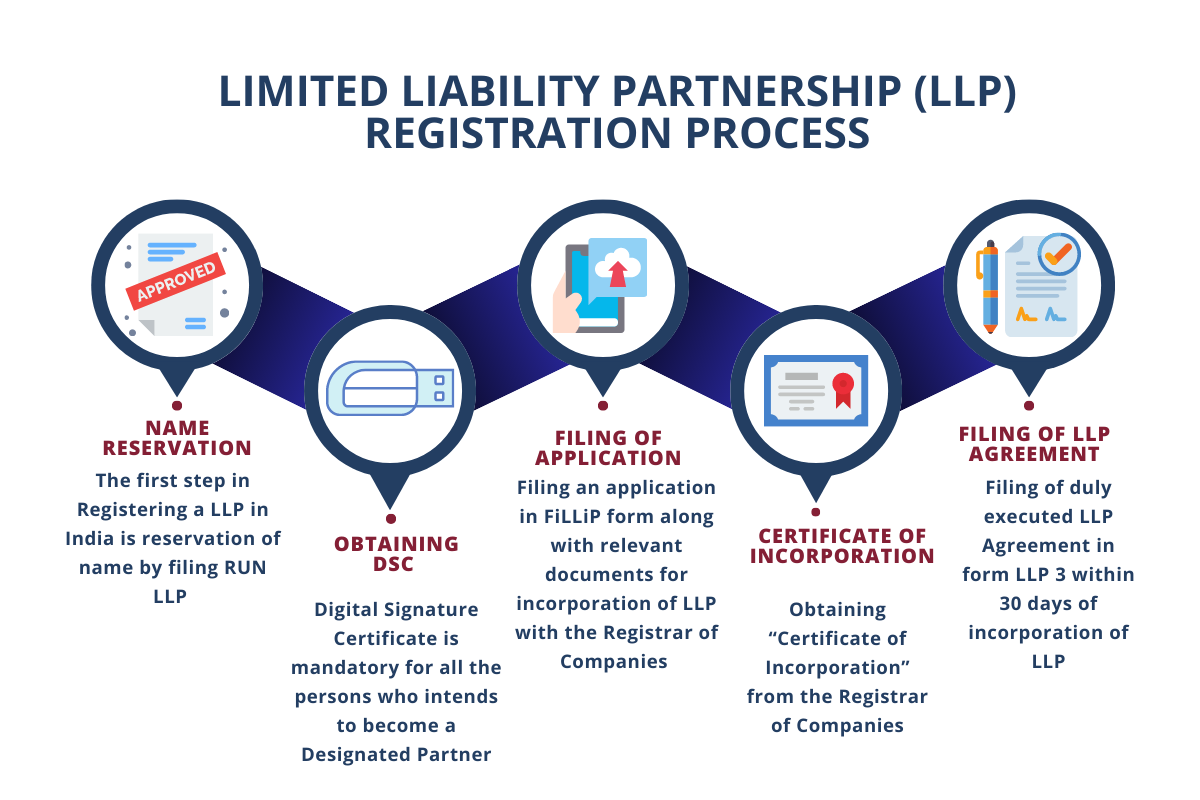Introduction:
As many companies are established in the evolving market space in India, limited liability partnerships emerged as a new breed that enjoys both the flexibilities associated with partnership and the advantage of having limited liability like a company. Those who want to form a limited liability partnership (LLP) have to know well all that relates to registration. This comprehensive guide aims to shed light on every aspect of the llp registration process india, equipping budding entrepreneurs with the necessary information required for a successful navigation of the process.
Step 1: Choose a Suitable Name
Selecting a name for a new LLP is very important because it should reflect the idea behind the establishment of this LLP. Nevertheless, this step cannot be viewed as an artistic endeavor per se but rather must comply with the MCA mandates. The chosen name must be unique and not infringe any trademark as provided by the MCA rules. As such, it is essential to first visit the MCA portals and see if the name to be registered is available to have an easy time throughout the registration process.
Step 2: Get DPIN(Designated Partner Identification Number).
Every member of a LLP should obtain a Designated Partner Identification Number (DPIN). The unique identifier that is received upon submission of an online app in the MCA portal. Essential papers such as identity and address proof should accompany the application. DPIN is a requirement to go through other stages in the registration of an LLP, underscoring the individuality of partners and compliance with law rules.
Step 3: Digital Signature Certificate (DSC) Acquisition
In the age of digital transactions, signatures have crossed over from paper-based. All the designated partners should acquire a Digital Signature Certificate (DSC) to ease the electronic signing of LLP registration documents. This step must be taken to ensure that only genuine documents are filed with the MCA. DSC is obtainable from certified authority and one of the vital steps in accepting the trend of digital practices in the business framework is the submitting of address and identity proof.
Step 4: LLP Agreement Drafting
The LLP Agreement is the main document that states the rights, duties, and responsibilities of each partner, as well as the internal rules of the LLP. The drafting of an extensive agreement about an LLP is not simply formal; it is required to carry on normally. Within a month of incorporation, this is a document that one files with the MCA which deals with issues like profit sharing proportions, capital contributions, and decision-making processes. An intelligently written LLP agreement is the road map for the management of the LLP, which ensures that partners operate in unison.
Step 5: Filing LLP Incorporation Form
Having approved the name DPIN, DSC, and well-formed Limited Liability Partnership agreement, the next vital move is filling out the LLP Incorporation Form. A comprehensive form that contains necessary aspects about the LLP such as name, registered office address, particulars of designated partners, and submitted LLP agreement. This electronic submission through the MCA portal is a key step toward the legal recognition of LLP. The act of this stage is the introduction of an LLP into the legal system.
Step 6: Certificate of Incorporation
On submission of the LLP incorporation form, RoC conducts intensive examinations and verifications. Through this procedure, any regulation or any form of control is followed. After this, the RoC will confirm that everything is in order before being issued with the Certificate of Incorporation. This document is considered conclusive evidence that the LLP exists and provides information such as; llin (LLP Identification Number) and the date the LLP was incorporated. The Certificate of Incorporation is a crucial step that marks the official recognition of the LLP within the law.
Step 7: PAN and TAN Application
After being assigned the Certificate of Incorporation, the LLP should proceed to other vital moves like applying for a PAN and TAN. They are compulsory for tax purposes and are bought from the online portal of the income tax department. TAN is used for tax deduction and remittance whereas PAN becomes an indispensable identifier for financial transactions in LLP. The steps highlight the incorporation of LLP into the wider financial and taxation realm.
Step 8: Opening a Bank Account
The LLP now has the status of a legal entity and, therefore, opens an account where it acts as a legal owner. Documentations in the typical are the Certificate of Incorporation, filed LLP agreement as well as the PAN although specific requirements could differ among banks. The bank account is the major financial center of the LLP for performing financial activities and transactions. This is a vital stage in the process of setting up the practical and operative components of the LLP’s financial framework.
Step 9: Compliance with Statutory Obligations
Upon registration, LLP enters a statutory world where it has to carefully observe all its operations from the legal point of view. The focus shifts towards annual compliance which involves the submission of annual returns at the RoC, keeping true records of accounts, and following tax laws accordingly. Such ongoing commitment to compliance protects the LLP from penalties and legal issues enabling it to operate by the law. Therefore, keeping abreast of these statutory obligations is an ongoing process that keeps LLP alive and vibrant.
Conclusion:
In India, setting up an LLP is quite a journey that calls for careful consideration on the part of entrepreneurs. The journey starts with the creation of a novel name and runs through the acquisition of pivotal permits and licenses before forming the LLP onto a strong legal basis. An entrepreneur who goes carefully through these steps and seeks professional advice where it is needed should start his business knowing that his LLP is ready to meet the requirements of the law. This comprehensive guide does not only demystify the process for llp registration but also enlightens intending entrepreneurs on the essentials needed when starting an LLP in India.

